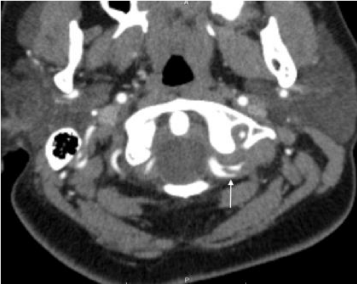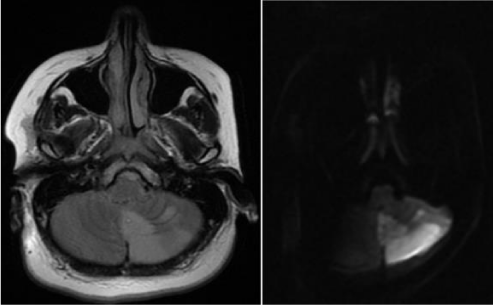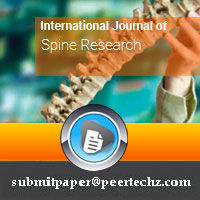International Journal of Spine Research
A Case report of Vertebral Artery Dissection following a cervical manipulation
Robert Nolan* and John Krauss
Cite this as
Nolan R, Krauss J (2019) A Case report of Vertebral Artery Dissection following a cervical manipulation. Int J Spine Res 1(1): 001-003. DOI: 10.17352/ijsr.000001Acute vertebral artery dissection is a very rare but known complication following cervical manipulation/chiropractic adjustments. We present a case of a 30 year old female who sustained a vertebral artery dissection following an upper cervical manipulation. Although there is no clear consensus on treatment options we discuss the current literature and treatment for this condition.
Introduction
Vertebral artery dissection is a rare condition that may follow mild neck trauma. The annual incidence of vertebral artery dissection is estimated at 1 to 1.5 per 100,000 and occurs in 0.01-1 percent of patients sustaining head and neck trauma [1-4]. When combined with carotid dissection they account for about 2 percent of all ischemic strokes, and 10 to 25 percent of strokes in patients under the age of 45.3,4.
The typical mechanism for vertebral artery dissection involves hyperextension or rotation of the neck. Seemingly innocuous activities such as yoga, painting a ceiling, swinging a golf club, coughing, vomiting, and sneezing have been implicated. This is in contrast to the more direct head and neck trauma sustained in a motor vehicle accident, or high impact sports related injury [2,3,5].
It has been estimated that stroke secondary to cervical chiropractic manipulation is as low as 1 to 3 incidents per million, to as high as 1 in 20,000 treatments [6-8]. Half of the patients presenting with vertebral artery dissection will complain of pain in the back of their neck, and two thirds complain of an occipital headache. Ischemic symptoms occur in more than 90 percent of patients and typically involve the posterior circulation [9].
Treatment for cervical artery dissection is focused on preventing thromboembolic complications with intravenous heparin followed by oral warfarin if presentation is greater than 4.5hrs from symptom onset. In acute treatment of vertebral artery dissection current literature supports thrombolytic therapy with medications such as alteplase for eligible patients [10]. This is based on imaging evidence demonstrating that more than 90 percent of dissection related infarcts are thromboembolic in nature, rather than related to insufficient blood flow [11]. One approach to management is to continue anticoagulation with MRA follow up at 3 and 6 months. If luminal irregularities persist, anticoagulation is continued, and typically patients are transitioned to antiplatelet therapy at 6 months [3,11-15].
A 30 year old female presented to the emergency department complaining of left sided neck pain, dizziness, and vomiting occurring shortly after chiropractic cervical manipulation. Physical exam was remarkable for the patient’s unwillingness to open her eyes, subtle left lateral gaze nystagmus, mild diplopia, and left sided cervical tenderness to palpation. Computed tomography angiography of the neck was performed (Figure 1A) demonstrating a left vertebral artery dissection, followed by magnetic resonance imaging (Figure 1B) demonstrating a left cerebellar infarct.
The annual incidence of spontaneous vertebral artery dissection is estimated at 1 to 1.5 per 100,000 and occurs in 0.01 percent of patients sustaining head and neck trauma [16-18]. The typical mechanism involves trauma, hyperextension or rotation of the neck [18]. Seemingly innocuous activities such as yoga, painting a ceiling, swinging a golf club, cervical manipulation, coughing, vomiting, and sneezing have all been implicated [17,19].
Regarding the management of our patient, three months of oral anti-coagulation were administered. Although, the CADISS trial suggests anti-platelet therapy is as effective for preventing recurrent stroke or death [20]. Endovascular or surgical interventions were not pursued as these modalities are currently reserved for patients with recurrent ischemic events despite medical therapy. Our patient’s three month follow up documented a good recovery with no major neurological sequelae or adverse
Discussion
Vertebral artery dissection is a rare complication of mild cervical trauma and can lead to thrombotic complications consistent with ischemic CVA’s this particular patient presented outside of the 4.5hr accepted window for intravenous thrombolysis per current AHA guidelines. Had she presented within 3 hours of onset she likely would have been administered intravenous thrombolytic therapy. Isolated vertebral dissection can be treated acutely with anti-thrombotic therapy which is believed to be slightly superior to anti-coagulation however there is little to no data to support this treatment and both are considered acceptable [11]. In most cases, excellent recovery is expected in 70-85% of patients. The rate of recurrent ischemic symptoms after dissection ranges from 0-13% in various studies.
Conclusion
We present a case of a 30 year old female who suffered from a vertebral artery dissection following a chiropractic cervical manipulation. She presented after 4.5hours from symptom onset and was treated with aspirin and unfractionated heparin with excellent 3 month outcome.
- Lee VH, Brown RD, Mandrekar JN (2006) Incidence and outcome of cervical artery dissection. A population-based study. Neurology 67: 1809-1812. Link: https://tinyurl.com/y3kvzcyc
- Majidi S, Hassan AE, Adil MM (2014) Incidence and outcome of vertebral artery dissection in trauma setting: Analysis of national trauma data base. Neurocrit Care 21: 253-258. Link: https://tinyurl.com/y2anfq6f
- Schievink WI (2001) Spontaneous dissection of the carotid and vertebral arteries. N Engl J Med 344: 898-906. Link: https://tinyurl.com/yxzo37gt
- Redekop GJ (2008) Extracranial carotid and vertebral artery dissection: A review. Can J Neurol Sci 35: 146-152. Link: https://tinyurl.com/y5fgceob
- Yamada SM, Yoshiaki G, Murakami M (2014) Vertebral artery dissection caused by swinging a golf club: Case report and literature review. Clin J Sport Med 24: 155-157. Link: https://tinyurl.com/yyu2smsz
- Assendelft WJ, Bouter LM, Knopschild PG (1996) Complications of spinal manipulation: A comprehensive review of the literature. J Fam Pract 42: 475-480. Link: https://tinyurl.com/y4ovfkv4
- Vickers A, Zollman C (1999) ABC of complementary medicine. The manipulative therapies: osteopathy and chiropractic. BMJ 319: 1176-1179. Link: https://tinyurl.com/y32axzq6
- Haldemen S, Carey P, Townsend M (2002) Clinical perceptions of the risk of vertebral artery dissection after cervical manipulation: The effect of referral bias. Spine 2: 334-342. Link: https://tinyurl.com/y2dzytfj
- Silbert PL, Mokori B, Schievink WI (1995) Headache and neck pain in spontaneous internal carotid and vertebral artery dissections. Neurology 45: 1517-1522. Link: https://tinyurl.com/y6me3nvu
- Lyrer P, Engelter S (2010) Antithrombotic drugs for carotid artery dissection (Cochrane Review). Cochrane Database Syst Rev 10: CD000255. Link: https://tinyurl.com/y2mxxkxl
- Lucas C, Moulin T, Deplanque D (1998) Stroke patterns of internal carotid artery dissection in 40 patients. Stroke 29: 2646-2648. Link: https://tinyurl.com/y4ze5oo8
- Arauz A, Ruiz A, Pacheco G (2013) Aspirin versus anticoagulation in intra- and extracranial vertebral artery dissection. Eur J Neurol 20: 167-172. Link: https://tinyurl.com/y6aqqwk9
- Cassidy, David J (2009) Risk of vertebrobasilar stroke and chiropractic care: results of a population-based case-control and case-crossover study. Journal of manipulative and physiological therapeutics 2: S201-S208. Link: https://tinyurl.com/yxcua2bw
- Whedon James M (2015) Risk of stroke after chiropractic spinal manipulation in medicare B beneficiaries aged 66 to 99 years with neck pain. Journal of manipulative and physiological therapeutics 2: 93-101. Link: https://tinyurl.com/y4gy8jnq
- Kosloff, Thomas M (2015) Chiropractic care and the risk of vertebrobasilar stroke: results of a case–control study in US commercial and Medicare Advantage populations. Chiropractic & manual therapies 23. 1: 19. Link: https://tinyurl.com/y5yodvov
- Church, Ephraim W (2016) Systematic review and meta-analysis of chiropractic care and cervical artery dissection: no evidence for causation. Cureus 8: e498. Link: https://tinyurl.com/y4koec3k
- Markus H, Hayter E (2015) Antiplatelet treatment compared with anticoagulation treatment for cervical artery dissection (CADISS): a randomised trial. The Lancet Neurology 14: 361-367. Link: https://tinyurl.com/y2rnf6ow
- Kernan WN, Ovbiagele B (2014) Guidelines for the prevention of stroke in patients with stroke and transient ischemic attack: a guideline for healthcare professionals from the American Heart Association/American Stroke Association. Stroke 45: 2160-2236. Link: https://tinyurl.com/y2g3cp43
- Cassidy JD, Boyle E, Cote P, He Y, Hogg-Johnson S, et al. (2008) Risk of vertebrobasilar stroke andchiropractic care: results of a population-based case-control and case-crossover study. Spine (Phila Pa 1976). 33: S176-S183. Link: https://tinyurl.com/jatovkm
Article Alerts
Subscribe to our articles alerts and stay tuned.
 This work is licensed under a Creative Commons Attribution 4.0 International License.
This work is licensed under a Creative Commons Attribution 4.0 International License.



 Save to Mendeley
Save to Mendeley
